Every guitar player can relate to the disappointment of dull-sounding and gross-feeling strings that just won’t stay in tune. Most of the time, you can rectify these issues easily with a new set of strings.
If you’re a beginner guitarist (or even a lazy intermediate player), then you might be wondering how often to change guitar strings to avoid getting to that point in the first place.
Ideally, you should change your guitar strings after every 100 hours of playing as they get worn out. If not in use, then changing your strings every three months is ideal as residual moisture from your fingers or in the air can wear them out even if the guitar has not been played. To summarize, change guitar strings every 100 hours, every three months, or when they physically feel dirty.
However, the answer depends on what type of guitar you have, and the types of strings you are using. Are you using an acoustic guitar or an electric guitar? Does your acoustic guitar take steel strings or nylon strings? What type of steel strings are you using – 80/20 or phosphor bronze, coated or uncoated? All of these affect the frequency of string changes.
Read on to find out how often to change guitar strings.
Post Contents
Why You Should Change Your Guitar Strings
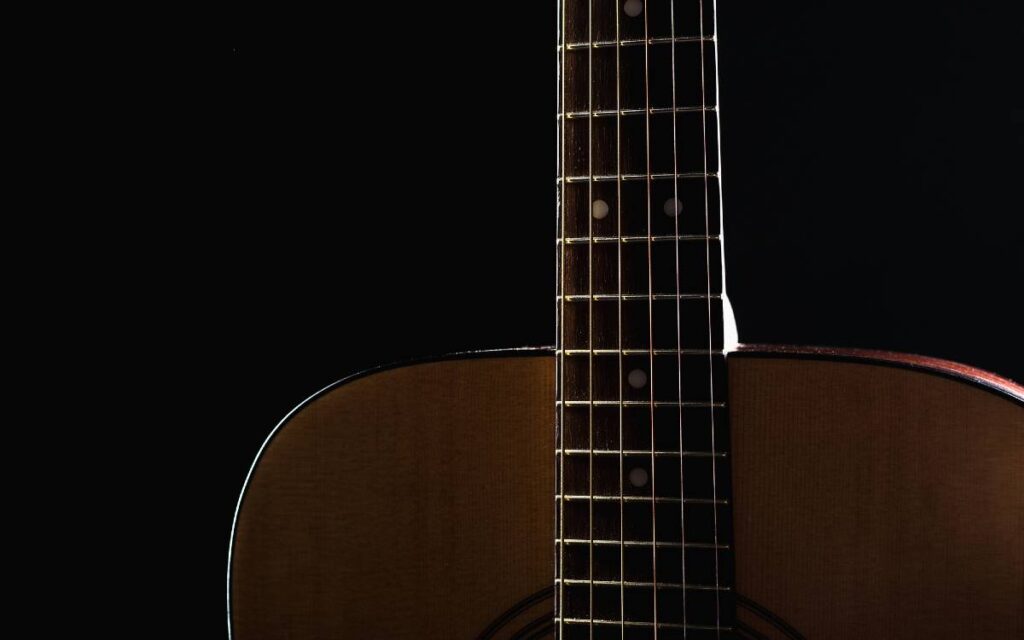
Your guitar strings can change over time, whether it’s due to environmental changes or wear and tear when you play your guitar. There are several reasons why you might want to change your guitar strings.
Breakage of the String
Older guitar strings have a better chance of breakage compared to newer ones. Every time you press down on a string, it rubs against the fret, which causes tiny little inconsistencies in it.
If you have an old string lying around, on close inspection, you will notice that there are minuscule dents where it has been worn down.
Obviously, you’ll need to change the string if you’ve broken one. Unless you’re playing a gig or rehearsing and need to be quick, it’s often a good sign you should replace all the strings with a fresh set.
If you keep breaking new strings, then there may be an issue with your guitar.
The Fresh Feeling of New Strings
Fresh strings feel better to play as they are completely clean and free of any degradation. Over time, grime buildup and oxidation can change the feeling of the strings.
A rusty string is never fun to play with and always sounds worse than a fresh one.
If you use coated strings on your guitar, you will notice the coating gets flaky after a while. It’s a good idea to change the string as soon as you see the coating start to peel away.
Winding Issues
This is due to acoustic guitar anatomy. Strings in a guitar are wound and tightened using a tuning peg. Sometimes, the peg can become loose on acoustic guitars and cause issues with the guitar’s tuning and sound stability.
Therefore, acoustic guitar strings can become slack over time, and continuing to use older strings doubles down on this problem. If a particular string is having trouble staying in tune, then it’s probably time for you to change the whole set.
Sometimes just returning the guitar will fix it temporarily, but you’ll notice you have to tune up much more frequently.
If you play a nylon string acoustic guitar, then you’re more likely to notice the top strings begin to loosen and the need to retune even more often than a steel string.
How Often to Change Guitar Strings
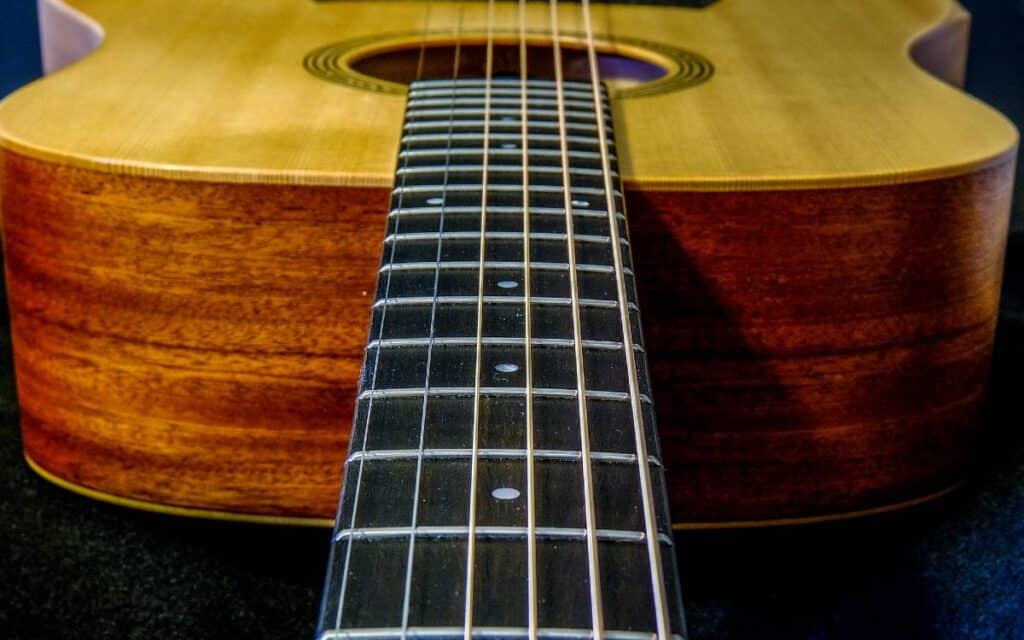
There are several things to consider when changing guitar strings. These include some of the following.
Usage Frequency
Let’s do some math on the 100 hours between changes we discussed earlier, as how much you play your guitar directly affects how often you should change your guitar strings.
If you play your guitar for 2-3 hours per day, you definitely should change the strings around once per month. If you play the guitar for around an hour per day, you should change the strings every two months. If you rarely play your guitar, then you can change your guitar strings after every three months.
Tuning and Performance
You should change the guitar strings if you’re having trouble tuning your guitar properly or the needle on your guitar tuner just can’t find the right spot.
If you’re having trouble executing certain techniques like sliding or string bending, then it’s probably time for you to change the guitar strings.
Sound
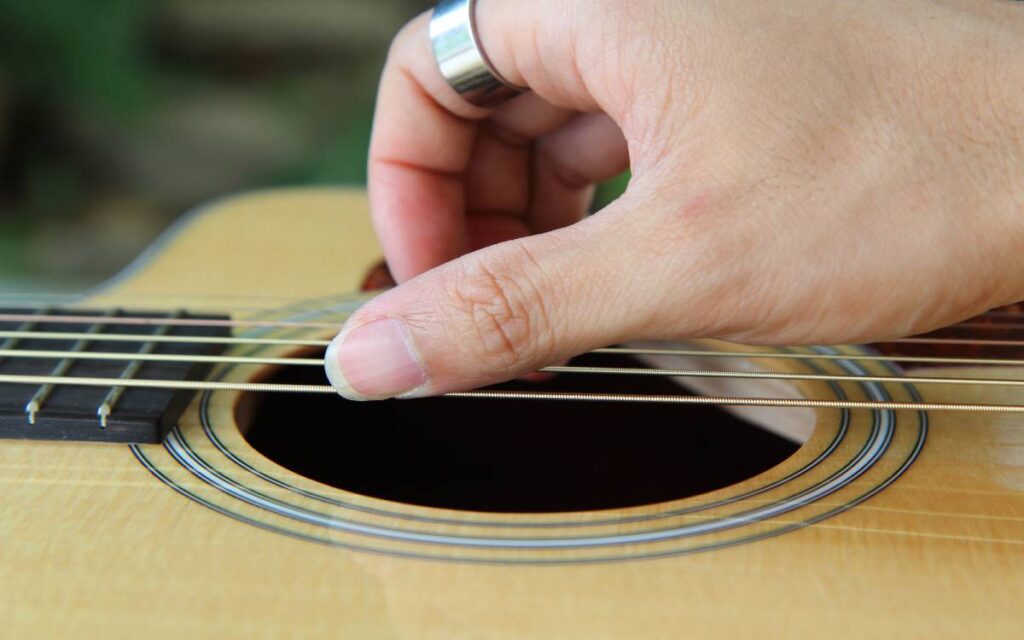
Your personal preference matters a lot when you’re thinking of changing strings. If you’re looking to have a brighter sound, you should change strings on your guitar. If you’re looking for a darker, more dull sound, then you should keep the older strings on your guitar.
Maintenance
How often do you clean your guitar? If you take care of your fretboard, then you won’t need to change your strings as often. If you don’t take care of your guitar, the strings can have dirt buildup, which will drastically impact the string’s sound and performance.
Budget
This can be one of the most important factors for some, as not everyone can afford to change their guitar strings every month. The cost of buying new strings every month can add up to a significant amount, especially if you prefer a premium string like Elixir strings.
Before a Gig
It’s a good idea to change strings before a gig, so your guitar doesn’t sound dull. Yet, you should play on the new string for about an hour before you take it on stage to avoid any tuning issues while you’re performing.
Why Do Strings Degrade?
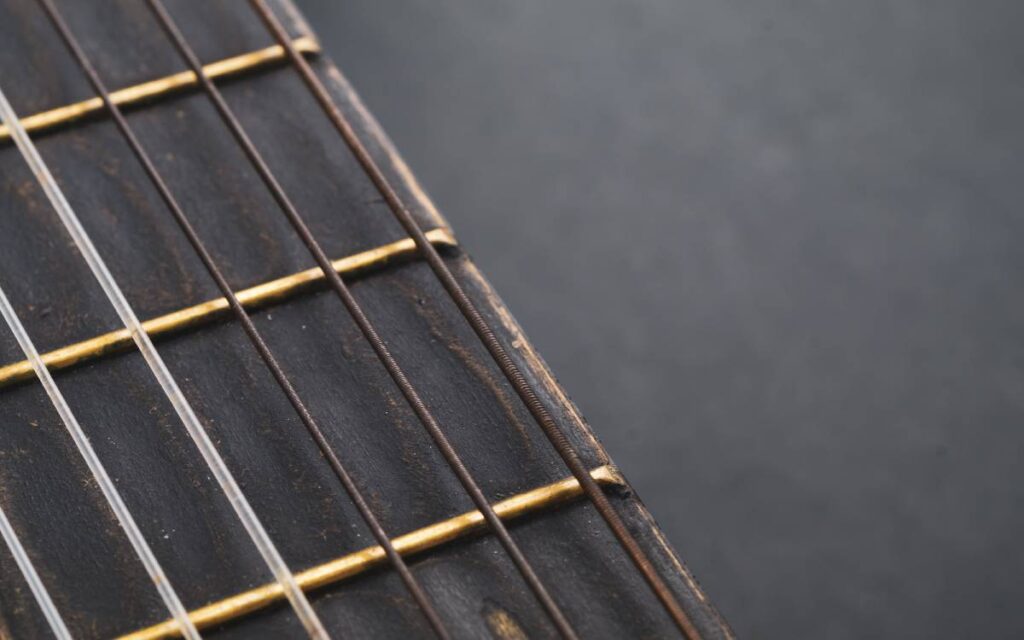
Strings can start degrading within the first few hours of playing. This happens due to the oil and microparticles from your fingertips. The more you play and the more the strings age, the more dirt, and grime will build up in the tiny grooves in the strings.
You may start to notice discoloration in the part of the strings where your fingers make contact with them. For example, if you play the A minor pentatonic scale a lot, you may start to see discoloration around the fifth and seventh frets.
Why Some People Replace the Strings Too Often
If you’re a professional guitarist, replacing your strings after every performance or recording session may be a good idea. It’s because you want to get the best tone for your recording and reduce the risk of string breaks during a performance.
However, one thing to know is that if you’re not a professional or you don’t play your guitar as often, then you don’t need to change your strings every two or three weeks. It’s overkill to change the strings every week, and you should change your strings when either they start to sound dull or one of them breaks.
Extending the Life of the Strings
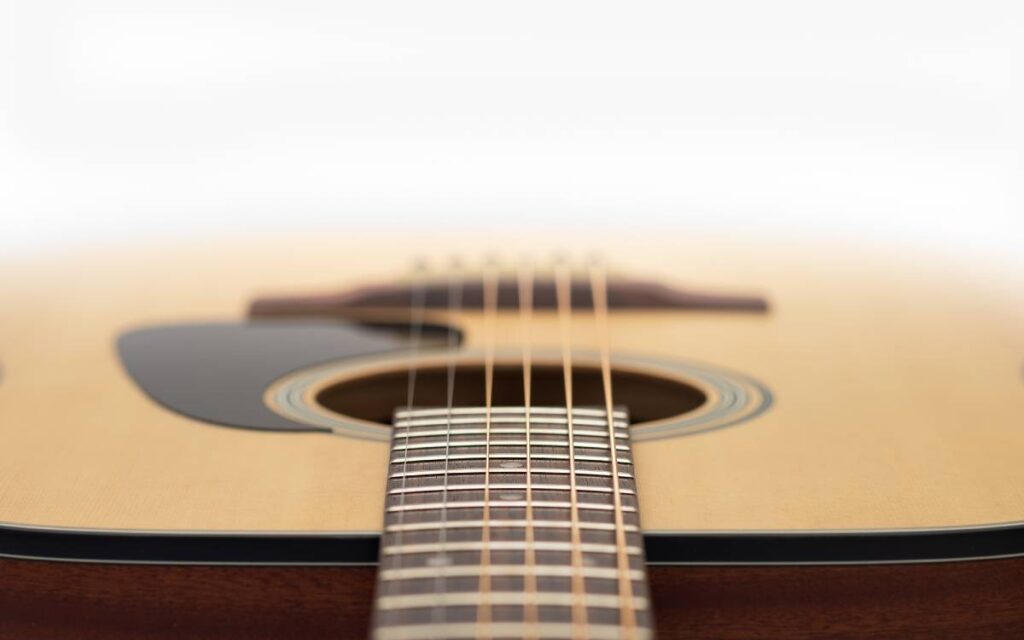
We know that the quality of the strings degrades over time. However, there are ways to slow down how often you have to change strings using the few tips we have provided below.
Clean Your Strings
Cleaning your strings regularly is something that you should make a habit of. Not only does it give your strings longer life, but it also keeps your guitar in its best shape. Cleaning the strings will rid them of oil, grime, and sweat buildup that not only ages your strings faster but also affects the sound quality of your guitar.
Keep a soft cloth handy and some string conditioner to clean the strings on the guitar as soon as you finish playing. It’s simple and makes sense, right?
Wash Your Hands Before You Play
You may think this is overkill, but washing your hands with soap can rid them of oil and dirt, which can help you get the most out of your strings. You should wash your hands with soapy water before every guitar session. This can also help to protect your untreated maple neck or any other open-pore neck.
Use String Cleaners
There are many products designed specifically to clean the strings of your guitar strings. These work essentially by creating a coating on your strings which helps to save them from corrosion.
Alternatively, you can use coated strings for the same purpose as they come with a coating on them that saves them from premature corrosion.
Changing the Guitar Strings

To change your guitar strings, you don’t have a lot of equipment other than a new set of guitar strings and wire cutters. However, it’s a good idea to have these on hand:
- String winder (optional)
- A new set of the same gauge strings that are already on your guitar
- A tool to cut the ends off the strings
Before You Start
Try to figure out what gauge your current strings are and buy a set with the same stats. This will help prevent your guitar from needing additional setup after a string change. The intonation on your guitar may get out of whack from changing to a lighter or heavier set of strings.
Loosen the Old Strings
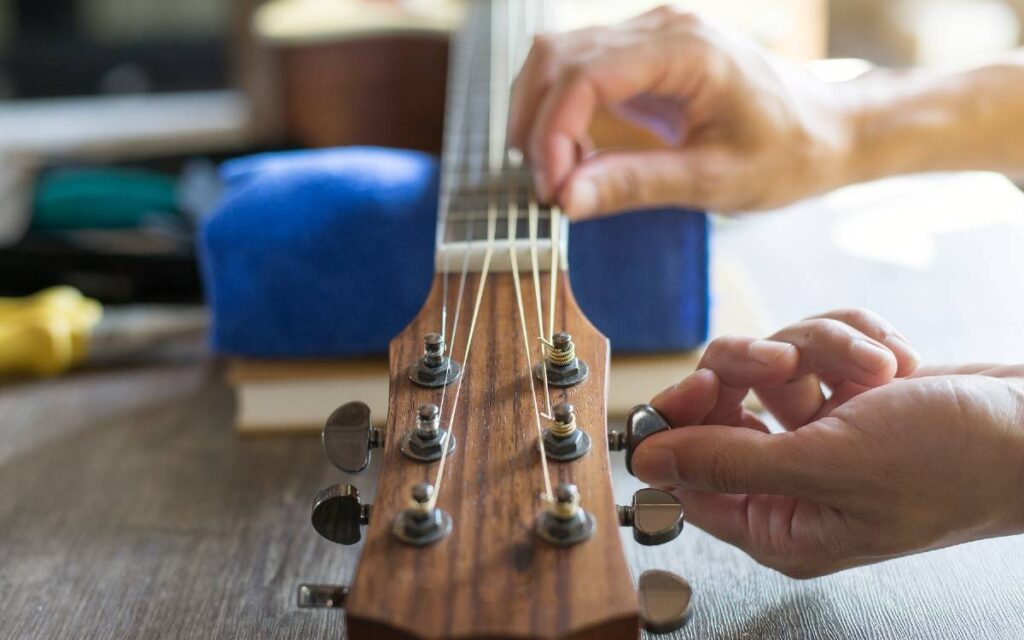
We don’t recommend taking all of the strings off at once unless you plan to clean your fretboard. Replacing one string is easy so let’s assume you’re going to clean your guitar thoroughly.
Taking a string off is very simple. Pluck the string and start loosening the machine heads on the headstock. You should hear the pitch of the sound dropping the more you unwind the machine head.
Make sure to listen to the string as you unwind it. If you’re turning the key the other way, the string tension will increase, and you may end up with a broken string.
Keep unwinding the string until you’re able to remove it completely, or just cut the string using the wire cutters. A pair of pliers may come in handy here, but with enough unwinding, you probably won’t need one.
Removing the String Ends
On most steel-string acoustic guitars, the string attaches to a ball secured by small pins into the guitar’s bridge. The pin needs to be removed to take out the string. This method applies to some electric guitar strings too. Others you will just have to reverse feed them through the body of the guitar.
Clean the Fretboard (Optional)
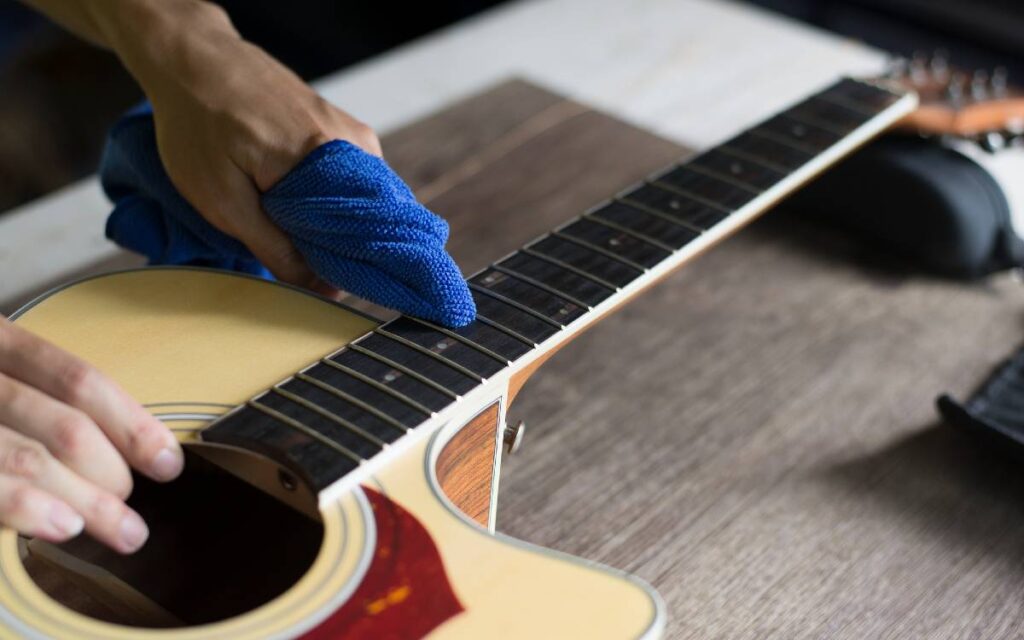
Once you have removed all of the strings from the bridge, you can give the fretboard a good clean. Use a cleaner to scrub any grime off the fretboard, especially around the frets.
DON’T use household soaps or anything like that. Only use approved and safe cleaning agents.
Once you’re done cleaning it, you can also use fret oil to give your fretboard that professional touch. Rub in a bit of oil till it’s gone leaving you with a shiny, clean, and fast fretboard.
Insert and Wind the New String

Start by securing the string to the bridge. Pull the loose end towards the neck of the guitar. Align the hole in the tuning peg with the fretboard and pass the string through the slot in the peg. Hold the string firmly and start winding the tuning machine counter-clockwise.
After one revolution, you can start to loosen your grip as you have to remove your hand from under it. Try plucking the string once you feel like it’s wound up tightly enough, and you should hear a sound similar to the note it should make, albeit an untuned one.
Repeat the same steps for all of the remaining strings.
There are a few schools of thought as to whether you should hold the string low on the tuning peg or not. Have a look at how the strings were wound already and match the same style.
Cut Off the Excess String
Use wire cutters to snip off the unneeded loose ends. These can be found on most pliers. You can even use a nail clipper if you find yourself in a pinch. You don’t need to leave out any excess string if you installed the strings properly. If you don’t have any tool to clip the strings handy, you can make loops at the end of your guitar with them until you find one.
Tuning the Guitar
Use a guitar tuner to tune every string. You may need to repeat this step several times as each string is still creating tension in the neck, affecting the tuning of the others.
Once you start playing, you will notice your strings going out of tune very quickly.
Fret not, as retuning it a few times will help bring it back to normal. You can pull on the strings gently away from the neck as it can help fix the tension in the strings and balance it out properly to hasten the settling of the strings.
Frequently Asked Questions
What’s the Difference Between Uncoated Strings and Coated Strings?

Coated strings have a polymer coating on them that keeps them clean and protects them from natural elements. Uncoated ones don’t.
Coated acoustic strings don’t have the same amount of grime and dirt buildup. However, they can have a negative impact on the sound of your guitar.
We recommend using coated strings if you’re a musician who travels a lot and wants to elongate the time between string changes. You can also get more bang for your buck as you can maximize string longevity.
However, uncoated guitar strings do have a more vibrant brighter tone and feel much more natural. They provide a better grip and are cheaper than coated strings too.
Can Guitar Strings Go Bad in the Package?
No. Strings appropriately sealed in the package can last for years if unopened. If the packaging remains sealed, there is little to no chance of the strings rusting in the packaging as there is no moisture that can damage them.
However, be careful not to bend the strings. Sometimes even in the packaging, extreme bending can cause permanent kinks in the strings.
You can buy strings in bulk to save money, and as long as they are adequately sealed, you should be okay.
Are There Different Strings for Different Guitars?
Yes, the string type can change depending on your guitar. You’ll need acoustic strings for your acoustic guitar, electric strings for your electric, etcetera. There are also different string materials, such as 80/20 and phosphor bronze, that work better with different guitar body types. And you’ll need to pay attention to the gauge of the strings you’re putting on. If you’re unsure, take your guitar into a local music shop and get them to help you pick out the right set.
How Long Can Guitar Strings Last When Not Played?
Guitar strings can last a long time when not played. The strings will degrade naturally, depending on the humidity and the amount of dust in the place you choose to store your guitar when not playing.
Generally, a three-month gap after they’ve been opened but not played is still long enough for them to lose their best quality.
Should I Clean My Guitar Strings?

You should make it a habit to clean your guitar strings after every session. Wiping them with a soft microfiber cloth can help clean them of any oils left on them from your fingers. You can also use a string cleaner to clean your guitar strings.
Do not use water to clean the strings.
It’s also a great idea to wash your hands and dry them properly before you start playing.
Should I Change All the Strings at Once?
We recommend changing just one string at a time to keep tension on the neck of the guitar.
The only exception here is if you want to clean your fretboard thoroughly. This way, you can clean the dirt buildup from the strings and even polish the frets.
Remember that this can cause tuning stability issues as the tension in the fretboard changes, but it’s always worth the effort to clean your guitar. You may just need to see a guitar tech or luthier to set the guitar up again.
Should I Loosen the Strings When Not Playing?
Guitars are built to withstand the tension caused by wound strings, so there is no need to unwind the strings after playing. Winding and unwinding the strings using a string winder can cause tuning instability when done too much, so it’s best to avoid it.
Can I remove the rust from the strings?
No. We don’t recommend it as it can be more of a hassle to clean the rust off of the string than just to replace it with a brand new string.







